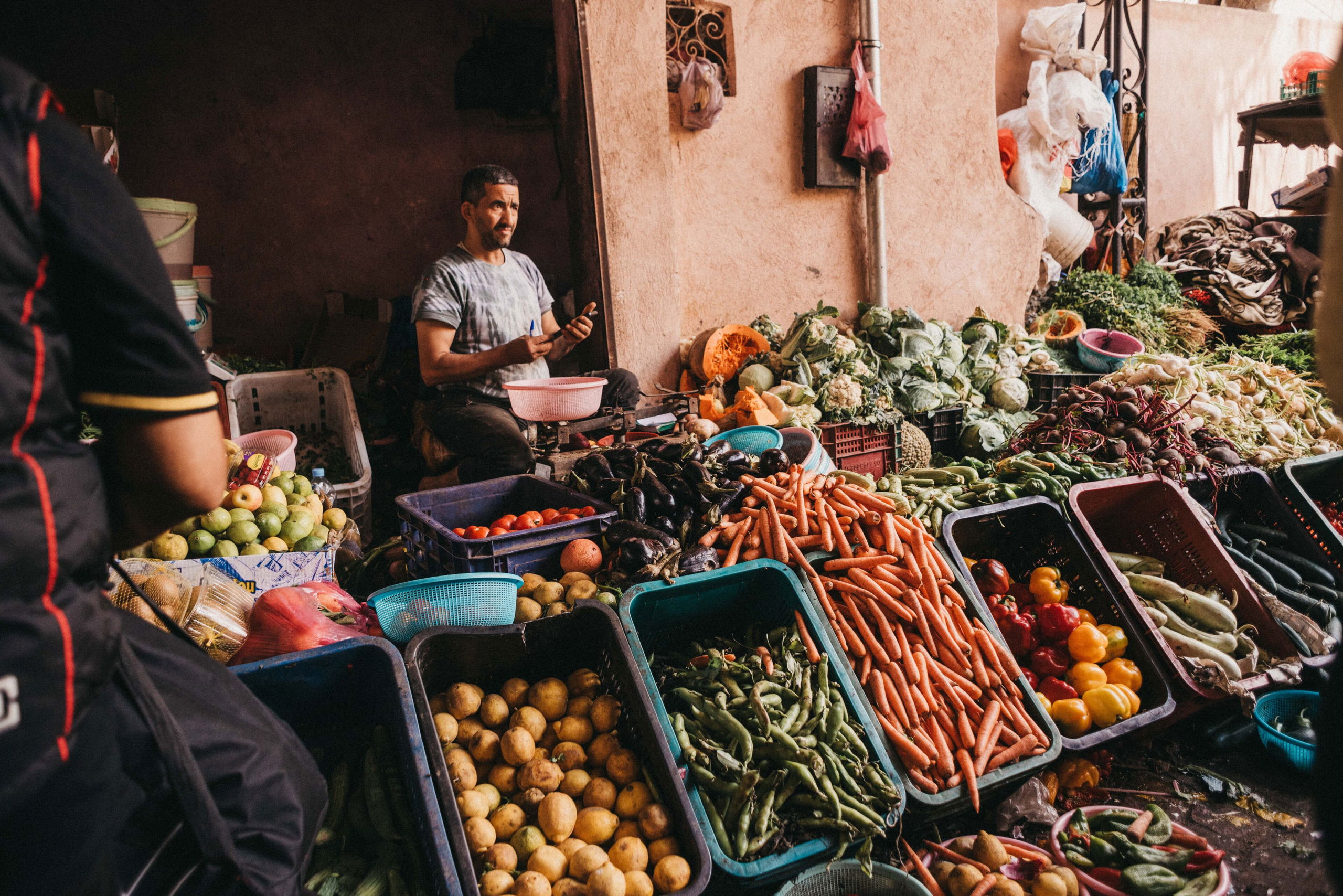
The first breath you take in Marrakech’s medina carries stories. Imagine cumin and coriander dancing with rose petals as the sharp tang of preserved lemons mingling with the honeyed warmth of dates ripening in the sun. These markets breathe life into Moroccan culinary heritage, and the families have occupied these same vendor stalls for generations.
The morning light filters through the medina’s ancient walls, casting geometric shadows across pyramids of spices that seem to pulse with color: turmeric golden as desert sand, paprika red as the Atlas Mountains at sunset, and black pepper that whispers of distant trade routes. This is where Marrakech food culture tells the story of a thousand-year-old civilization built on flavor.
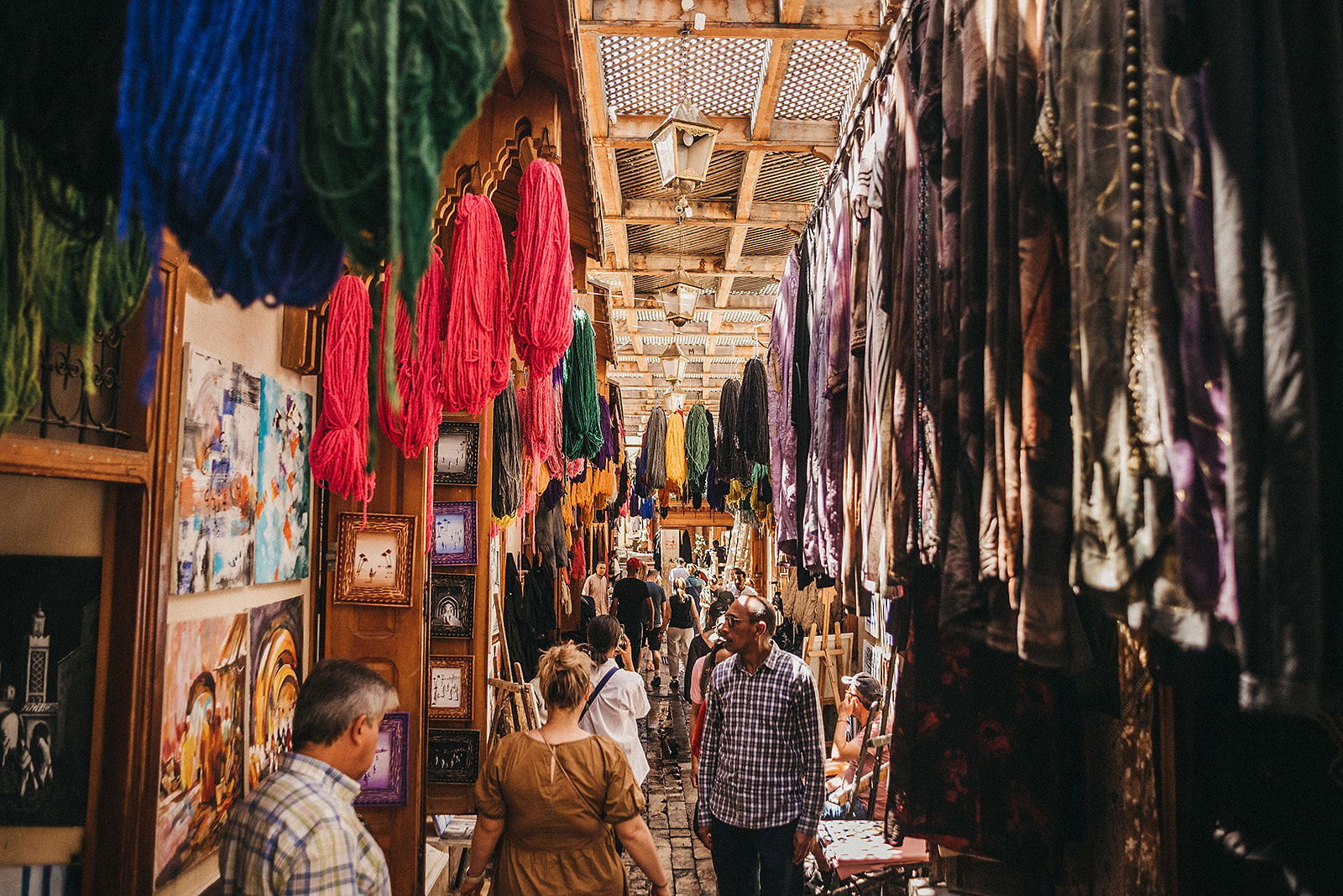
Journey Through the Medina’s Food Scene
Within the medina’s labyrinthine passages, over 40,000 vendors serve roughly 300,000 visitors daily, creating one of North Africa’s most dynamic culinary ecosystems. The market stretches across nearly 1,500 acres, but its heart beats strongest in the food quarters, where smoke from charcoal braziers creates a perpetual haze that carries the essence of grilled meats, flatbreads, and slow-simmering tagines.
The medina’s food landscape tells Morocco’s story through layers of influence—Berber foundations seasoned with Arab innovations, enriched by Andalusian refugees, and refined by centuries of trans-Saharan trade. Here, traditional cooking methods survive unchanged: clay tagines that have been shaped by the same family’s hands for four generations, wood-fired ovens that bake bread using techniques perfected during the Almoravid dynasty, and spice blends ground on stone mortars worn smooth by countless daily rituals.
The sensory symphony begins before dawn, when bakers fire their ovens and the first batches of khubz, round, pillowy bread with a golden crust that shatters between your teeth, emerge steaming. The aroma draws early risers who know that the finest loaves disappear within hours, claimed by housewives who’ve risen before the call to prayer to secure their families’ daily bread.
Essential Marrakech Market Navigation Tips
Navigate the medina’s food scene like a local by arriving between 7 and 9 AM, when vendors display their finest products and the crushing afternoon crowds haven’t yet descended. The market’s geography follows ancient logic: grain sellers cluster near the main entrances, their sacks of barley and wheat requiring easy cart access, while delicate items like pastries and fresh herbs occupy the more protected interior passages.
According to local vendors, tourist stalls typically cluster around major landmarks while authentic merchants occupy less obvious locations throughout the medina. The key lies in observing where Marrakech residents actually shop. Following locals leads to vendors who prioritize quality and fair pricing over tourist convenience. Local customers create the best compass; they know which fishmonger receives the freshest catch from Essaouira, which baker produces the fluffiest msemen, and which tea seller stocks the premium gunpowder green that transforms ordinary mint tea into liquid poetry.
The medina’s narrow alleys can disorient newcomers, but food provides reliable navigation markers. The scent of fried fish signals proximity to the seafood quarter, while the sharp bite of fermented olives indicates you’re near the pickle vendors who’ve perfected their brines using recipes passed down through five generations. The sound of mortar against pestle leads invariably to the spice merchants, whose grinding creates the market’s heartbeat.
The Art of Haggling for Fresh Ingredients
Haggling in Marrakech transcends mere price negotiation; it’s a cultural dance that honors both buyer and seller. The ritual begins with “As-salamu alaykum” (peace be upon you), followed by inquiries about family and health. Only after this social foundation can business commence, and rushing this process marks you immediately as an outsider.
Key phrases smooth negotiations: “Shukran, lakin ghali bezef” (thank you, but too expensive) signals serious interest while requesting a better price. “Ma fiha shi” (no problem) indicates acceptance, while “Yallah, khaliha” (come on, give me a break) expresses friendly exasperation that often triggers vendors’ final concessions. The process requires patience; successful haggling unfolds over mint tea and conversation, not hurried exchanges between strangers.
Understanding seasonal pricing prevents overpaying: citrus fruits cost least in winter when they’re harvested, while summer brings premium prices for delicate herbs that wilt in the heat. Locals know that Thursday and Friday see higher prices as vendors prepare for weekend crowds, making Tuesday and Wednesday optimal for serious shopping.
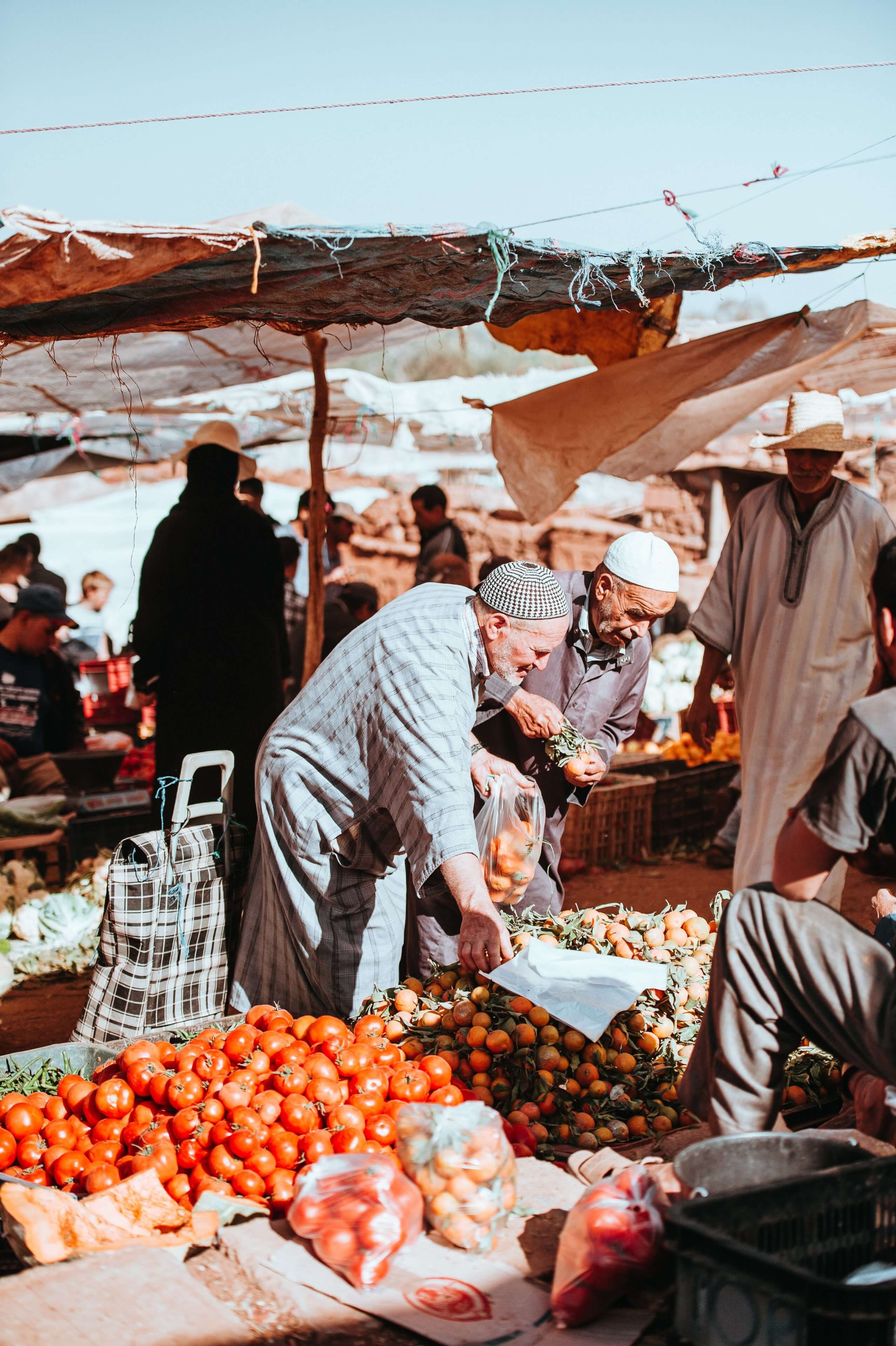
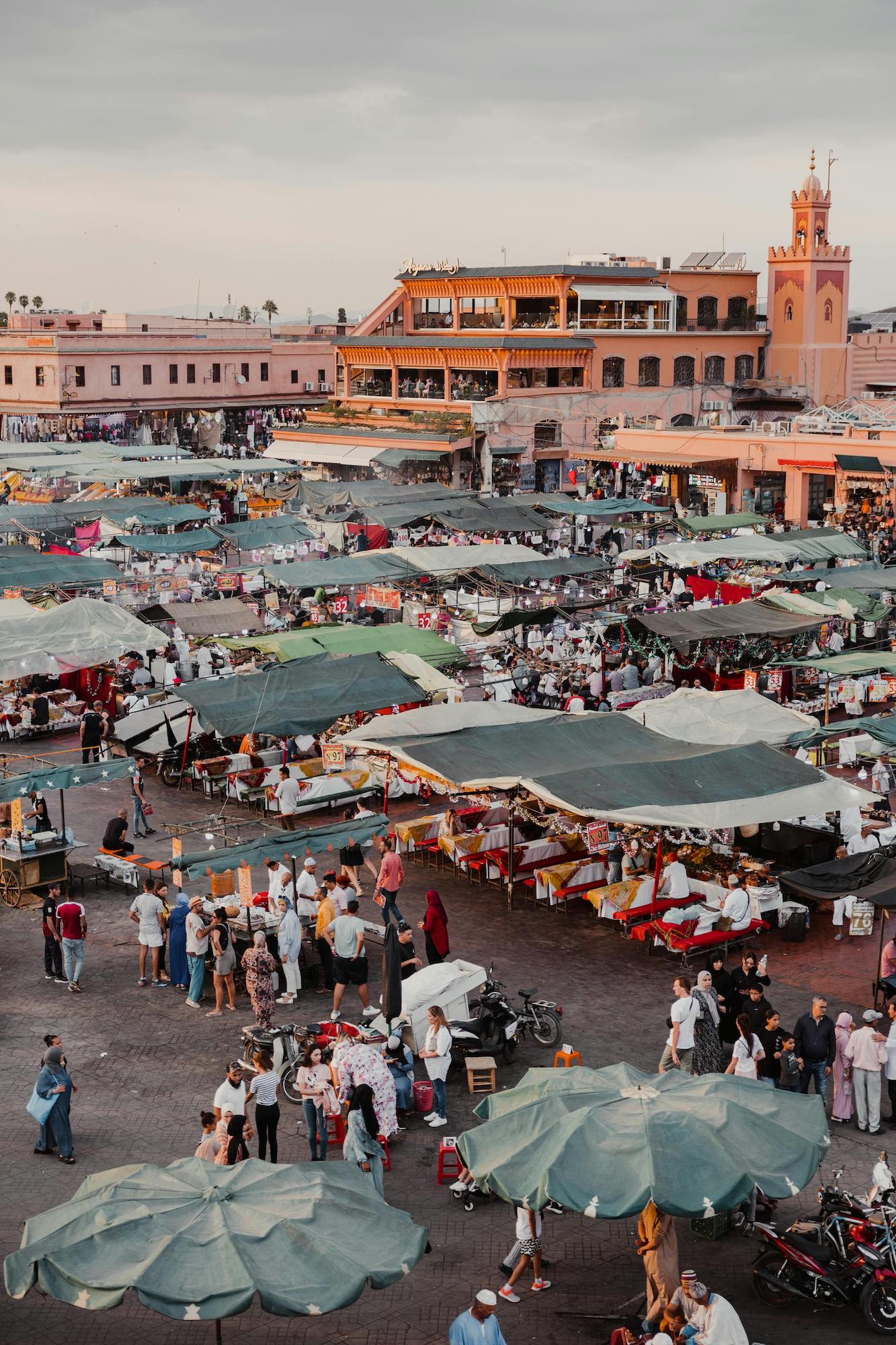
Must-Try Street Food Locations
The medina’s street food geography rewards exploration beyond the obvious tourist magnets. In the Rahba Kedima spice square, charcoal braziers send aromatic smoke curling through the air as vendors grill meat skewers using marinades that blend preserved lemon, fresh herbs, and spices prepared fresh each morning. These grilling stations typically operate from 11 AM to 11 PM, their corner locations chosen strategically so that the enticing aromas draw customers from neighboring alleys.
The lamb kefta found here, formed by experienced hands into perfectly seasoned meat cylinders, carries flavors that speak to Morocco’s pastoral traditions while satisfying contemporary palates seeking authentic Marrakech street food experiences. The cooking technique remains unchanged for generations—slow grilling over natural charcoal that imparts subtle smokiness impossible to achieve with gas flames.
Near the cloth merchants’ quarter, msemen carts attract lines of locals who wait patiently for paper-thin pancakes stretched and folded with techniques that transform simple dough into flaky, buttery layers. Vendors typically begin preparation at 6 AM, working until their dough supply is exhausted by about 2 PM. These msemen, served warm with honey or stuffed with herbs and cheese, represent Moroccan breakfast tradition at its most refined.
The Mellah quarter features vendors specializing in loubia, where white beans slow-cook in sauces enriched with preserved lemons and olive oil until they achieve a creamy consistency that coats wooden spoons like silk. These humble dishes, served from carts wheeled into position each morning around 8 AM, demonstrate how Marrakech cuisine transforms simple ingredients into sophisticated comfort food.
Traditional Marrakech Dishes
The foundation of Marrakech cuisine rests on dishes that have fed this desert city for centuries, each recipe refined through generations of cooks who understood that surviving in this climate required foods that nourished deeply while using local ingredients efficiently. These traditional preparations reveal Morocco’s culinary philosophy: maximum flavor extracted from minimal resources, achieved through time, technique, and an intimate understanding of how spices interact with proteins, vegetables, and grains.
Pastilla, perhaps Marrakech’s most celebrated dish, exemplifies this sophisticated approach. Layers of tissue-thin warqa pastry encase a filling traditionally made from squab, though chicken versions now dominate restaurant menus. The filling combines savory elements—shredded poultry seasoned with ginger, saffron, and preserved lemons—with sweet additions like cinnamon and powdered sugar, creating a flavor profile that challenges Western expectations while satisfying deeply.
Tagine Mastery: From Market to Table
The iconic cone-shaped tagine vessel represents more than cookware; it’s a masterpiece of engineering designed for Morocco’s climate. The conical lid creates a natural convection system, allowing moisture to condense and drip back into the dish, preventing ingredients from drying out during long, slow cooking processes. This design enables complex flavor development using minimal liquid, which is crucial in a desert environment where every drop of water carries value.
Selecting ingredients for authentic tagine requires understanding how different components contribute to the final dish. In the market, choose lamb shoulder with visible fat marbling because the fat will render slowly, creating richness without greasiness. Preserved lemons should feel firm but yield slightly to pressure, indicating proper fermentation without over-saltiness. Fresh herbs like cilantro and parsley should display no wilting, their stems snapping cleanly when bent.
The cooking process begins with creating a flavor base called tfaya—onions cooked until golden, combined with ginger, turmeric, and saffron. This mixture forms the foundation for countless variations. Traditional lamb tagine with prunes requires precise timing: the meat browns first, then simmers with spices for 90 minutes before adding the prunes, which need just enough time to plump and release their sweetness without disintegrating.
Temperature control separates masterful tagine from mediocre attempts. The ideal heat allows gentle bubbling because vigorous boiling destroys the delicate textures that make tagine special. The final step involves garnishing with toasted almonds and fresh herbs, adding textural contrast to the silky, deeply flavored sauce.
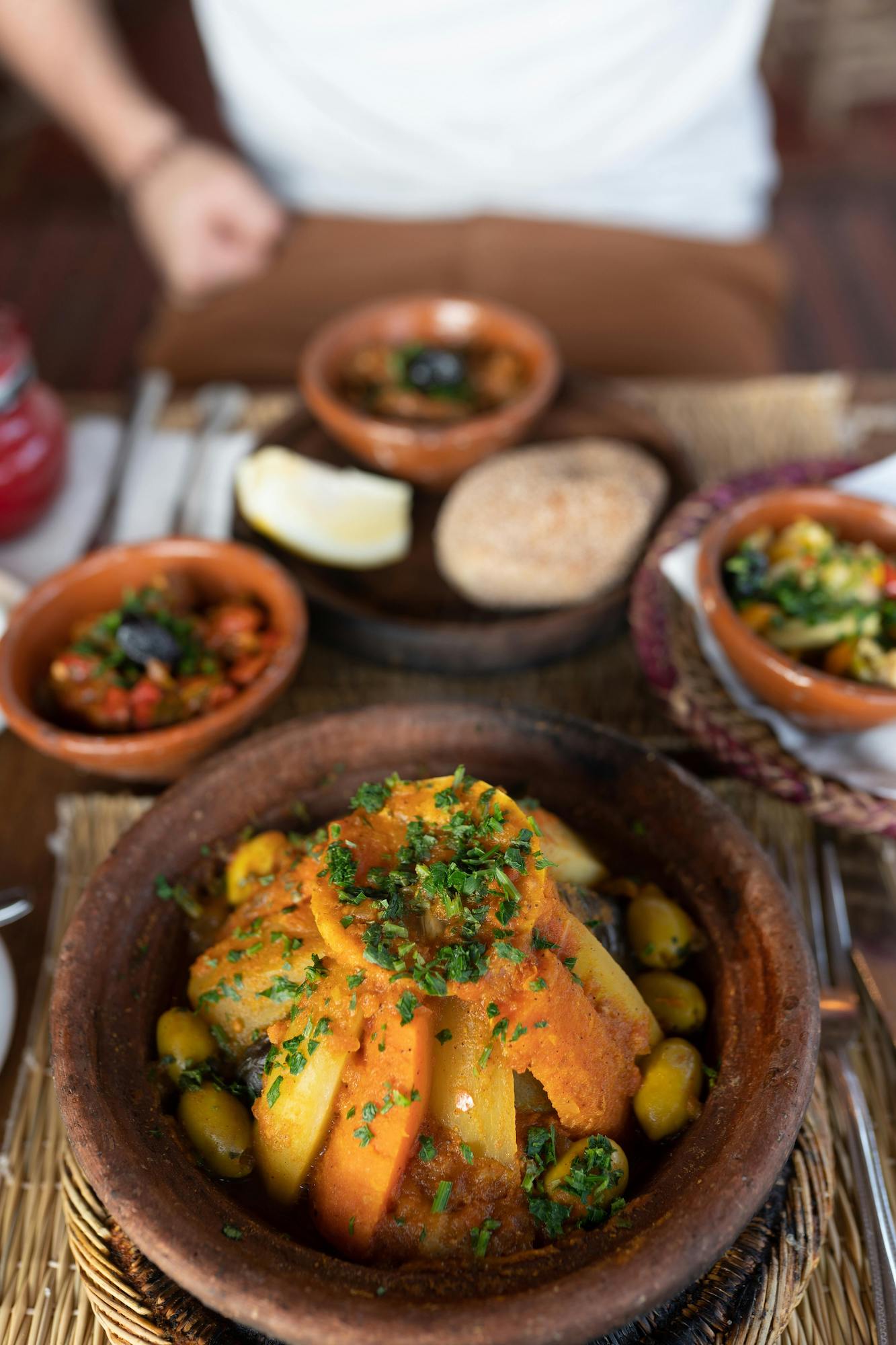
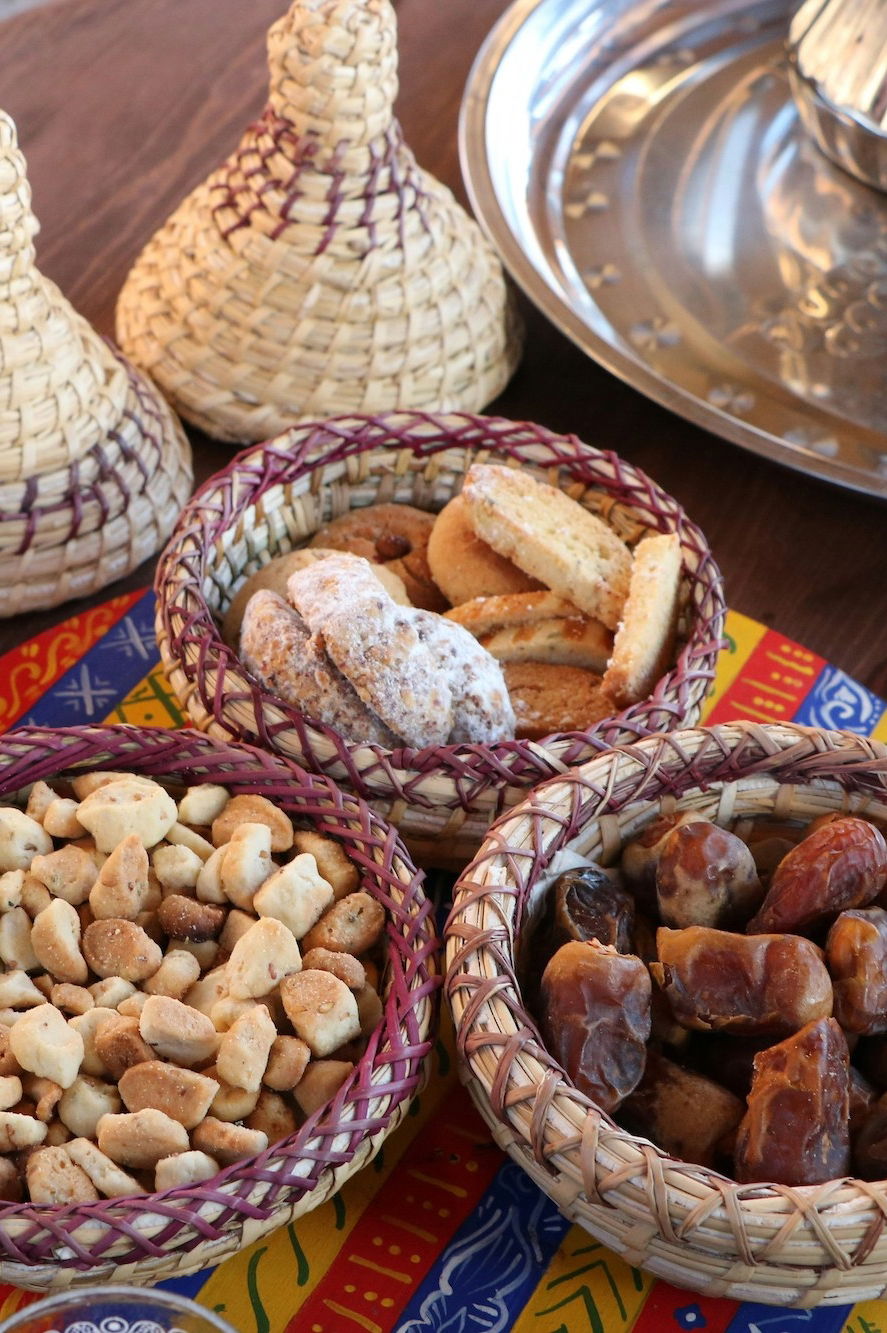
Sweet Treasures of the Souk
Marrakech’s pastry traditions reflect the city’s position at the crossroads of Arab, Berber, and Andalusian cultures. In the souk’s pastry quarter, glass cases display geometric arrangements of sweets that double as edible architecture—honey-soaked chebakia twisted into flower patterns, almond-filled briouats shaped like perfect triangles, and ma’amoul cookies pressed with wooden molds that imprint intricate designs into their surfaces.
Seasonal specialties mark religious and cultural celebrations. During Ramadan, shops overflow with dates stuffed with almonds and rolled in coconut, while Eid celebrations bring elaborate displays of gazelle horns—crescent-shaped pastries filled with almond paste perfumed with orange blossom water.
Local bakers guard their recipes zealously, but common elements unite most traditional sweets: the liberal use of almonds (often ground to paste), the perfuming with orange blossom or rose water, and the finishing with honey that’s been infused with aromatic herbs. These ingredients create sweets that satisfy without overwhelming, complementing the mint tea that serves as their traditional accompaniment.
Spice Market Secrets
The spice souk operates as both marketplace and sensory education, where vendors arrange their wares in colorful pyramids that seem to glow with inner light. Here, the art of spice blending reaches its zenith, with merchants who can identify dozens of varieties by scent alone and who understand how each component contributes to the complex flavor profiles that define Moroccan cooking.
Ras el hanout, literally “head of the shop,” represents the spice merchant’s ultimate achievement—a blend that might contain anywhere from twelve to thirty different spices, each added in precise proportions that create harmony rather than competition. The best versions include rose petals for floral notes, cubeb pepper for complexity, and grains of paradise for a subtle heat that builds gradually. Quality ras el hanout should smell intensely aromatic when fresh, with no single spice dominating the bouquet.
Identifying quality spices requires engaging all the senses. Fresh saffron displays deep red threads with orange tips, releasing its distinctive hay-like fragrance when pinched between fingers. Inferior versions appear lighter in color or include yellow stamens that add bulk without flavor. Cinnamon bark should snap cleanly, releasing sweet aromatics, while old cinnamon bends without breaking and smells musty rather than warm.
Storage wisdom passed down through generations emphasizes protecting spices from light, heat, and moisture. Traditional merchants use wooden boxes with tight-fitting lids, storing whole spices whenever possible since grinding releases volatile oils that dissipate quickly. Home cooks should purchase spices in small quantities, replacing them every six months to maintain maximum potency.
Common spice combinations reveal the logic behind Moroccan flavor building: ginger and cinnamon appear frequently in meat dishes, their warmth complementing rich proteins, while cumin and coriander provide earthy foundations for vegetable preparations. Understanding these partnerships enables creative cooking while respecting traditional principles.

Modern Meets Traditional
Contemporary Marrakech’s dining scene illustrates how tradition evolves without losing its essence. Young Moroccan chefs, many trained in European culinary schools, return home with techniques that they apply to ancestral recipes, creating dishes that honor their heritage while appealing to international palates. This evolution reflects Morocco’s broader cultural dynamic—a society comfortable with modernity while maintaining deep connections to its past.
This modernization extends beyond restaurant kitchens into the markets themselves, where traditional vendors increasingly cater to food-conscious tourists seeking authentic ingredients. Organic produce sections have emerged within the medina, offering vegetables grown without pesticides alongside heritage varieties that nearly disappeared from commercial cultivation. These developments reflect growing awareness among both locals and visitors about the connections between traditional farming methods and superior flavor.
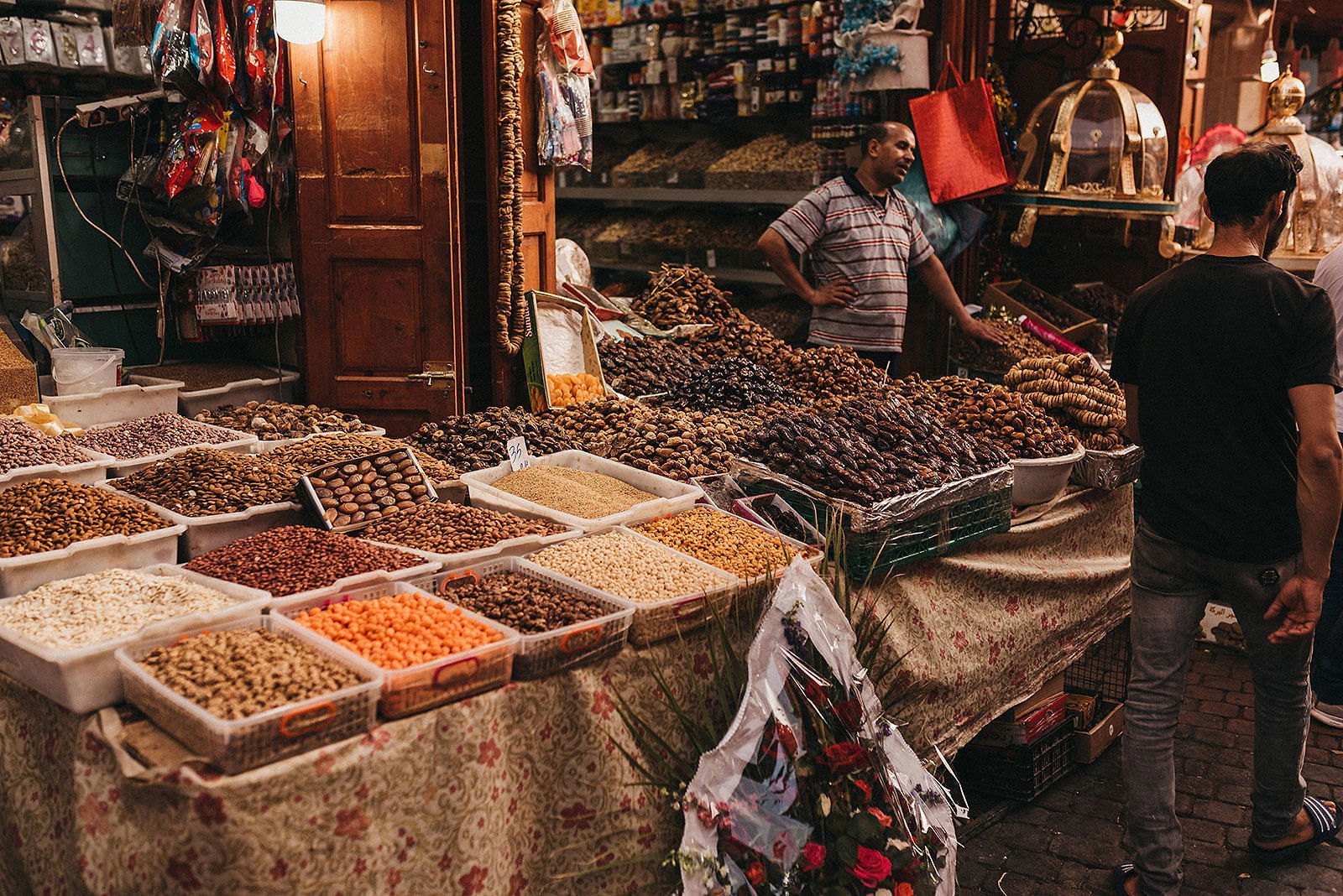
Chef Picks and Local Favorites
Marrakech’s most celebrated chefs maintain deep connections to traditional market suppliers despite their establishments’ contemporary reputations. The philosophy remains consistent across the city’s fine dining scene: the best ingredients haven’t changed in centuries, only the presentations have evolved to meet modern expectations.
Professional kitchens consistently source lamb from butchers in the medina’s meat quarter who dry-age their meat using traditional methods, hanging carcasses in cool, ventilated rooms where they develop concentrated flavors impossible to achieve through modern refrigeration. For vegetables, many chefs prefer women’s cooperatives that grow traditional varieties using organic methods, producing tomatoes with intensity that modern hybrids can’t match.
The city’s pastry professionals gravitate toward small-scale producers who maintain traditional methods. Bakeries tucked into narrow alleys near landmarks like the Saadian Tombs still fire their ovens with olive wood, creating subtle smokiness in their bread that gas ovens can’t replicate. Their khubz emerges with crusts that shatter audibly when broken, revealing interiors with irregular holes that speak to natural fermentation processes.
For spices, experienced chefs seek vendors who roast their own blends daily, the aromatic smoke from their small roasting pans creating localized fragrance clouds that draw customers from neighboring alleys. These merchants understand that spices reach peak flavor within hours of roasting, a knowledge that separates artisanal producers from commercial operations focused on shelf stability over taste.
Cooking with the Masters
During our trips to Morocco, the medina hosts cooking experiences where traditional techniques are passed from master to student through hands-on experience. Classes typically begin in the morning with market tours led by Tastemakers who demonstrate ingredient selection while explaining the cultural context behind traditional preparations. Guests learn to identify ripe avocados by their give under gentle pressure, to recognize premium dates by their glossy skin and plump appearance, and to negotiate fair prices while respecting local customs. This foundation proves essential since Moroccan cooking depends heavily on ingredient quality rather than complex techniques.
The cooking instruction emphasizes traditional methods: preparing couscous by hand-rolling semolina with saltwater until perfect granules form, a process requiring patience and practiced technique.
Tagine instruction focuses on understanding heat control and timing. Learn to recognize the gentle bubbling that indicates proper cooking temperature, too vigorous and the ingredients break down, too gentle and flavors fail to develop properly.
Bringing Marrakech Home
Recreating authentic Marrakech food experiences in home kitchens requires understanding which elements translate successfully and which substitutions maintain dish integrity while accommodating ingredient availability. The challenge lies in capturing the depth of flavor achieved through traditional techniques while adapting to different equipment, climates, and ingredient sources.
The foundation begins with spice blending. Home cooks can approximate authentic ras el hanout by combining readily available spices: cumin, coriander, paprika, turmeric, ginger, cinnamon, and black pepper form the base, while cardamom, cloves, and nutmeg add complexity. Toast whole spices in a dry pan until fragrant before grinding, releasing essential oils that create more intense flavors than pre-ground versions.
Preserved lemons present the biggest challenge since commercial versions often lack the complexity of traditionally prepared ones. Home preservation requires only lemons, coarse salt, and patience. Pack quartered lemons with salt in sterile jars, ensuring they remain submerged in their released juices. After one month, they develop the distinctive pickle flavor that enhances tagines, salads, and meat preparations.
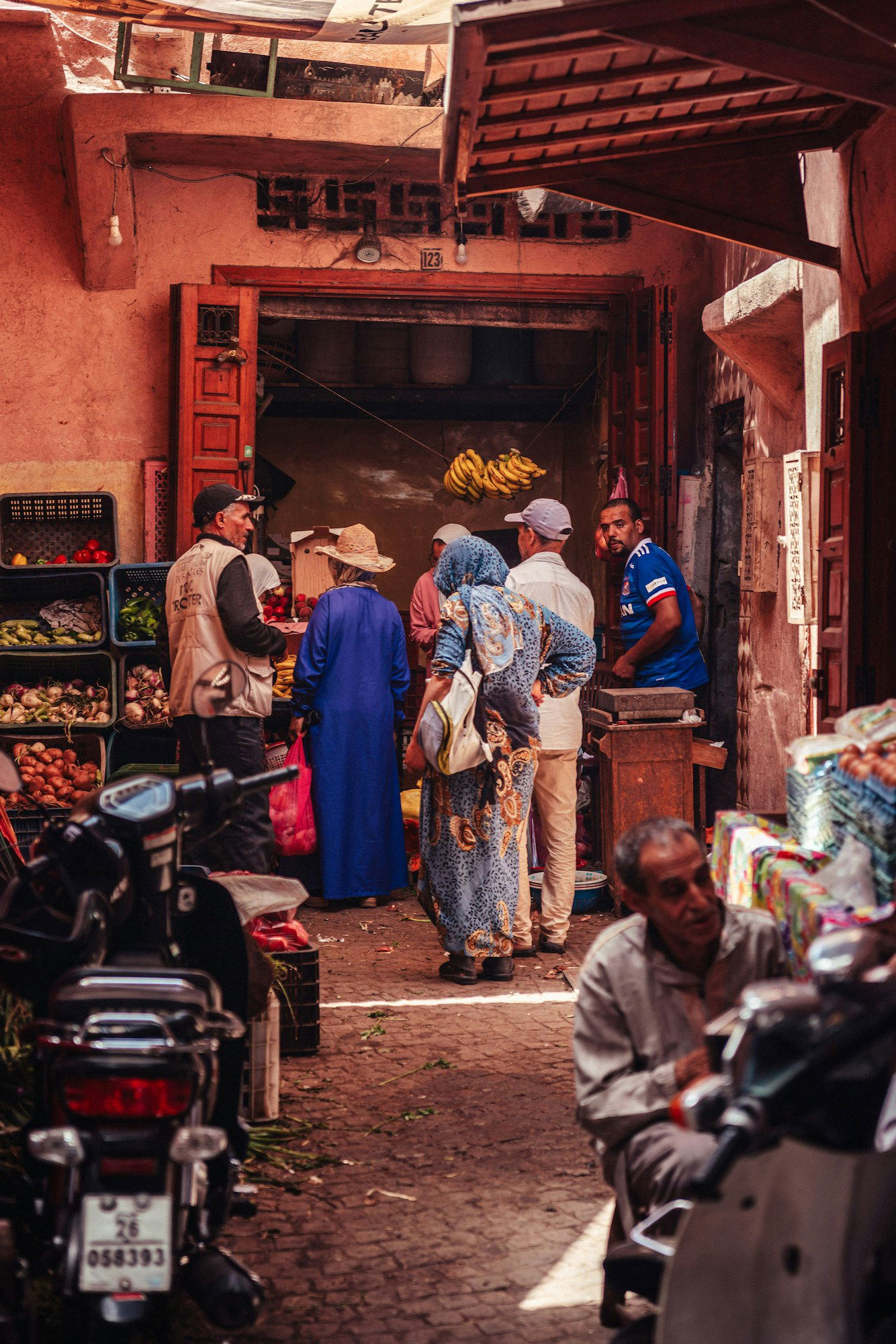
What to Buy Before You Leave
Marrakech markets offer numerous products that transport well and enable authentic cooking at home. Spices top most shopping lists, but selecting wisely ensures quality and longevity. Whole spices like cinnamon bark, whole nutmegs, and cardamom pods maintain potency longer than ground versions. Saffron represents the most valuable purchase, but be sure to buy from reputable vendors who allow inspection of individual threads.
Argan oil deserves special consideration since authentic versions remain difficult to source outside Morocco. Choose cold-pressed varieties with golden color and nutty aroma, avoiding refined versions that lack characteristic flavor. Store in dark bottles away from heat to preserve quality.
Traditional cookware makes meaningful souvenirs with practical applications. Tagine pots require careful packing but reward home cooks with authentic cooking capabilities. Season new tagines before use by soaking in water overnight, then cooking rice or another starchy dish to seal the clay surface. Wooden spoons carved from olive wood develop character through use and last for decades with proper care.
Tea glasses and serving trays enable recreating Moroccan hospitality traditions. The ritual of mint tea service—hot, sweet, poured from height to create foam—transforms simple refreshment into cultural performance. Practice the pouring technique to develop the characteristic high arc that aerates the tea while creating dramatic visual appeal.
Preserved items like harissa paste and rose water travel well and provide authentic flavoring for months after returning home. Date paste, packed in small containers, sweetens desserts naturally while adding complex flavors impossible to achieve with refined sugars.
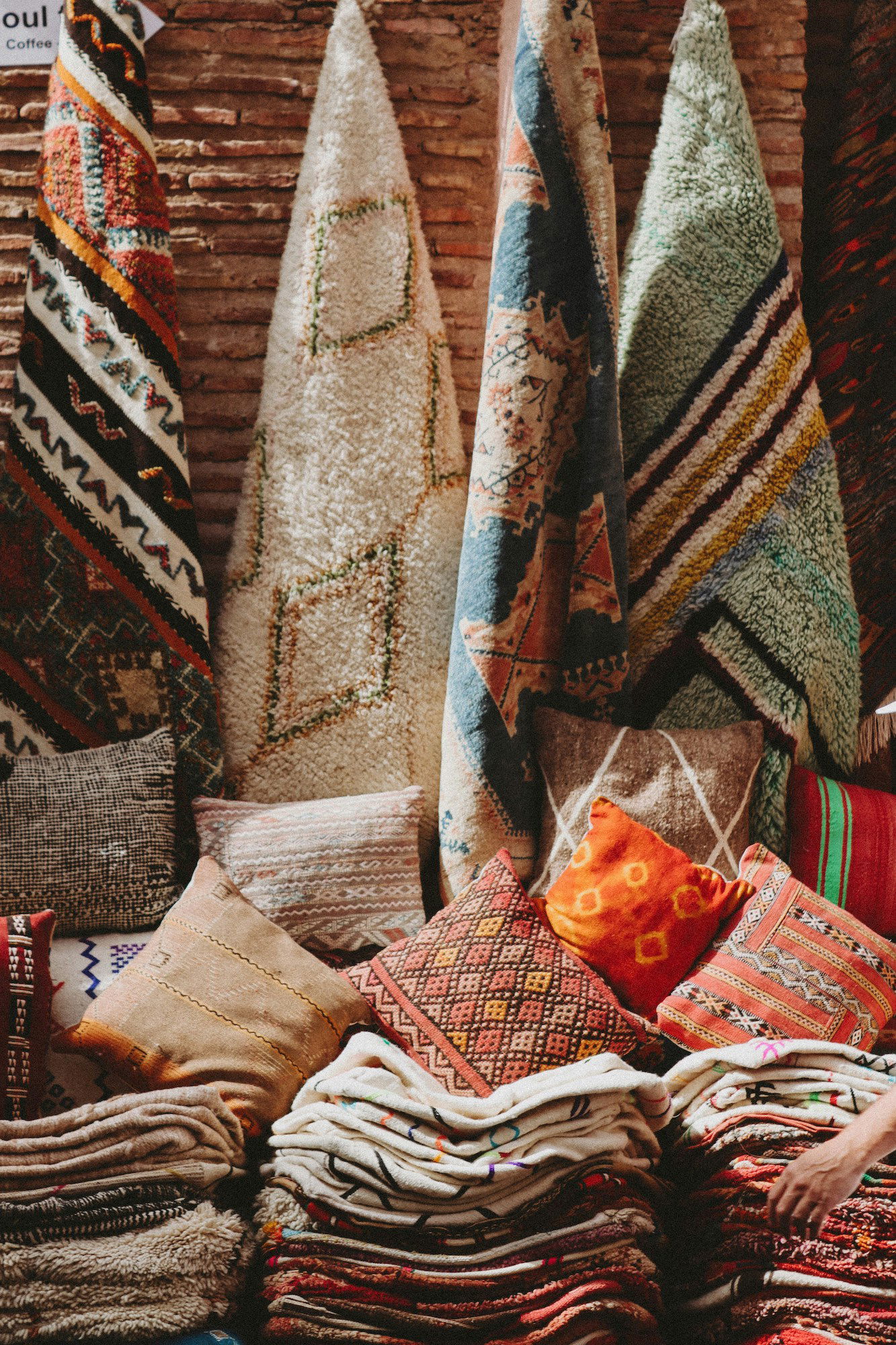
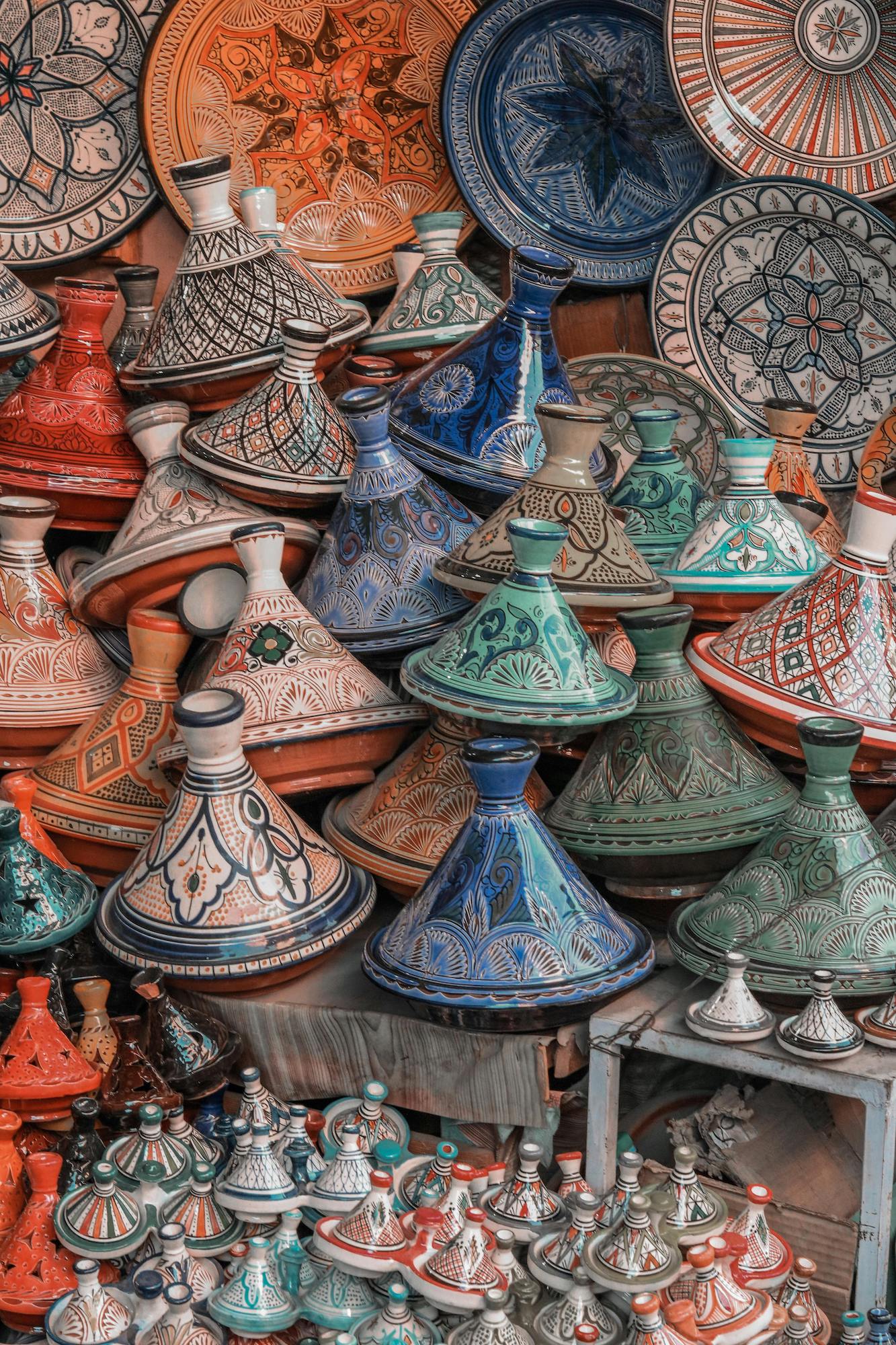
Your Market Journey Awaits
Planning a culinary exploration of Marrakech’s markets requires understanding seasonal rhythms and cultural patterns that affect both ingredient availability and market dynamics. The optimal timing balances weather considerations with cultural events that might limit access or create exceptional opportunities for food experiences.
Winter (November-February) provides authentic experiences with fewer tourists, allowing deeper interactions with vendors and more relaxed exploration. Traditional winter foods like warming tagines and hearty soups dominate restaurant menus, while preserved foods showcase Morocco’s historical food preservation techniques. Cold morning temperatures make early market visits more comfortable, though shorter daylight hours limit exploration time.
The holy month of Ramadan creates unique opportunities and challenges. Markets operate on altered schedules, with increased activity before dawn and after sunset as families prepare iftar meals. Special Ramadan foods appear, including traditional sweets and drinks served only during this period. However, many restaurants close during daylight hours, limiting dining options for visitors.
For luxury Morocco travel experiences that maximize culinary discovery, consider guided programs that provide insider access while respecting local customs. Our Morocco food tour with Logan Cox or Sayat and Laura Ozyilmaz combines market exploration with hands-on cooking instruction, creating immersive experiences that transform passive observation into active participation. These structured itineraries balance education with entertainment, ensuring guests understand cultural context while enjoying memorable meals.
The magic of Marrakech’s markets lies not in checking items off shopping lists but in surrendering to sensory immersion that transforms understanding of food, culture, and the connections between them. These experiences create lasting memories that influence cooking and eating habits long after returning home, carrying the essence of Moroccan hospitality into daily life through shared meals and stories that bridge cultures through the universal language of exceptional food.



